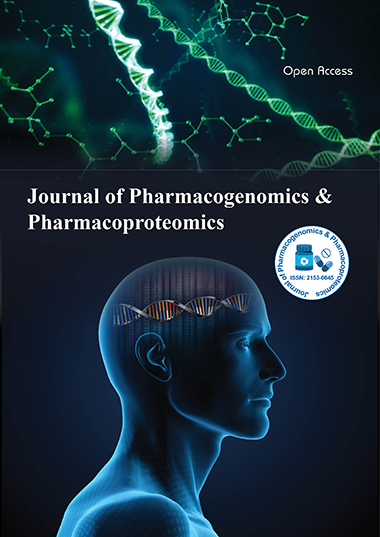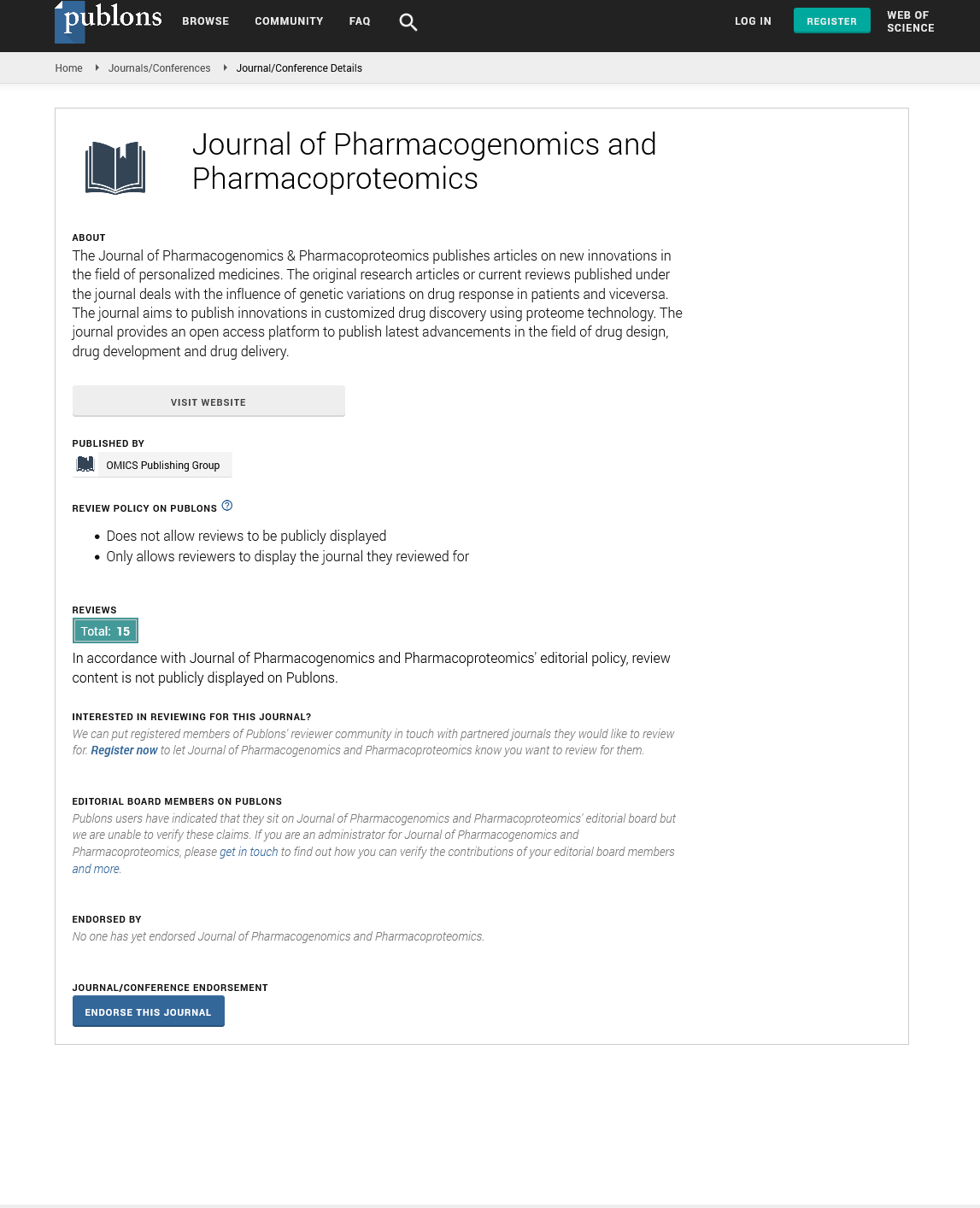Indexed In
- Open J Gate
- Genamics JournalSeek
- Academic Keys
- JournalTOCs
- ResearchBible
- Electronic Journals Library
- RefSeek
- Hamdard University
- EBSCO A-Z
- OCLC- WorldCat
- Proquest Summons
- SWB online catalog
- Virtual Library of Biology (vifabio)
- Publons
- MIAR
- Euro Pub
- Google Scholar
Useful Links
Share This Page
Journal Flyer

Open Access Journals
- Agri and Aquaculture
- Biochemistry
- Bioinformatics & Systems Biology
- Business & Management
- Chemistry
- Clinical Sciences
- Engineering
- Food & Nutrition
- General Science
- Genetics & Molecular Biology
- Immunology & Microbiology
- Medical Sciences
- Neuroscience & Psychology
- Nursing & Health Care
- Pharmaceutical Sciences
Perspective - (2023) Volume 14, Issue 3
Gene Expression of Dual Transcriptomic and Epigenomics Approaches in Investigating Reaction Severit
Michael Tip*Received: 28-Apr-2023, Manuscript No. JPP-23-21662 ; Editor assigned: 02-May-2023, Pre QC No. JPP-23-21662 (PQ); Reviewed: 17-May-2023, QC No. JPP-23-21662; Revised: 25-May-2023, Manuscript No. JPP-23-21662 (R); Published: 01-Jun-2023, DOI: 10.35248/2153-0645.23.14.053
Description
Dual transcriptomic and epigenetic techniques are providing researchers with the tools they need to get closer to unlocking the secrets of reaction severity. Dual transcriptomics involves examining both gene expression and genetic variation in the same sample, while Epigenomics looks at molecular modifications that control how genes are expressed. Together, these two techniques provide scientists with an unprecedented level of insight into how reactions vary from person to person. By studying how genetic variations and epigenetic changes interact at a cellular level, researchers can begin to identify which genes may be responsible for different levels of reaction severity in individuals. In addition to understanding individual differences in reactions, dual transcriptomics and Epigenomics can also help us understand how environmental factors affect our responses. For instance, by studying gene expression patterns in different environments, scientists can begin to identify which genes are more affected by certain environmental conditions than others. This could lead to a better understanding of how certain environmental triggers can cause severe reactions in some people but not others. By combining dual transcriptomics and epigenomics, researchers have a powerful toolkit for deciphering the secrets of reaction severity. By uncovering the genetic and epigenetic factors that influence our responses to different stimuli, we can gain valuable insights into why some people react more severely than others and what we can do about it.
Studying how the body responds to different stimuli is a key component of understanding human health and disease. Researchers have recently turned to dual transcriptomic and epigenetic techniques as powerful tools for investigating reaction severity in response to external factors. Transcriptomics is the study of gene expression, or the process by which genetic information is converted into protein. It can be used to measure gene activity in cells, tissues, and whole organisms. Epigenomics is the study of epigenetic modifications, which are chemical modifications that affect gene expression without changing the underlying DNA sequence. By studying both transcriptomic and Epigenomics data together, researchers can gain a better understanding of how genes are regulated within an organism in response to environmental factors. Dual transcriptomic and Epigenomics techniques have become increasingly popular among researchers due to their ability to detect subtle changes in gene expression that may not be apparent when only one type of data is studied. This enables researchers to more accurately measure reaction severity in response to various factors, such as toxins or drugs. Additionally, these techniques are highly sensitive and can detect changes at very low levels of exposure, making them useful for identifying potential biomarkers associated with different health conditions or diseases.
In recent years, there has been an increased focus on the use of dual transcriptomic and Epigenomics techniques to better understand reaction severity. By combining these two distinct approaches to analyze gene expression levels, scientists are able to gain a more comprehensive view of the underlying biology that leads to severe reactions in individuals. Transcriptomics is a field that focuses on understanding the expression of genes within a particular organism or tissue. It involves measuring the levels of messenger RNA (mRNA) molecules, which are responsible for carrying genetic information from DNA to ribosomes. This helps researchers identify which genes are active in a particular cell or tissue type and how they are expressed over time. Epigenomics, on the other hand, is concerned with studying chemical modifications that occur on DNA or its associated proteins. These modifications, known as epigenetic changes, can alter gene expression without changing the underlying DNA sequence. This makes them important for understanding how gene expression is regulated throughout development and in response to environmental cues. By using transcriptomic and epigenomics techniques together, scientists have gained valuable insights into why certain individuals experience severe reactions to certain stimuli. For example, by studying epigenetic changes associated with specific genes involved in immune responses, researchers have been able to identify potential targets for therapies aimed at reducing reaction severity.
The study of reaction severity is a complex and ongoing task, but thanks to recent advances in dual transcriptomic and epigenetic techniques, researchers now have the tools needed to gain insight into this crucial area. In this blog post, we'll take a closer look at the advantages of using dual transcriptomic and epigenetic techniques to study reaction severity. Dual transcriptomics and epigenomics are two powerful techniques that allow researchers to observe which genes are activated or suppressed under different conditions. By combining these two approaches, scientists can better understand how certain environmental conditions affect gene expression levels and consequently how they impact the severity of a reaction. The first advantage of using dual transcriptomics and epigenomics is that it allows researchers to analyze the gene expression patterns of many individuals simultaneously.
Citation: Tip M (2023) Gene Expression of Dual Transcriptomic and Epigenomics Approaches in Investigating Reaction Severity. J Pharmacogenom Pharmacoproteomics.14:053.
Copyright: © 2023 Tip M. This is an open-access article distributed under the terms of the Creative Commons Attribution License, which permits unrestricted use, distribution, and reproduction in any medium, provided the original author and source are credited.

